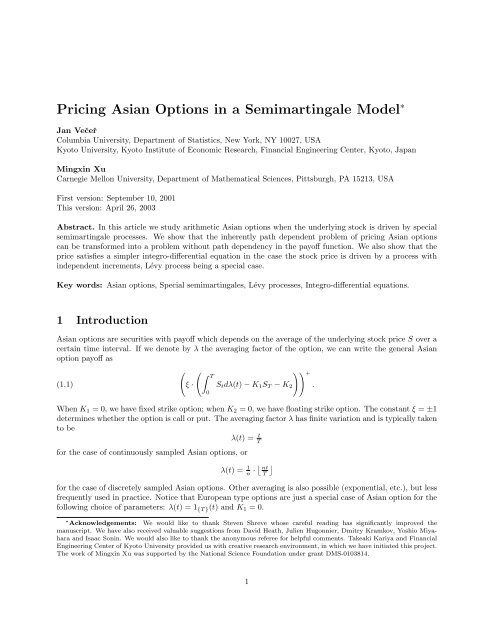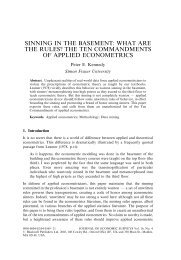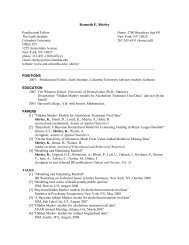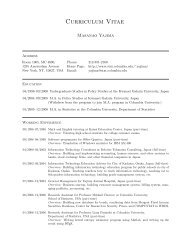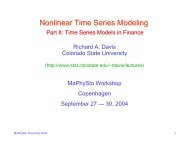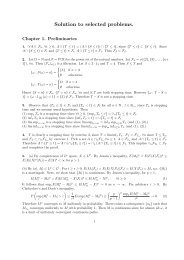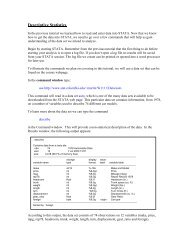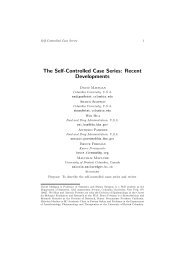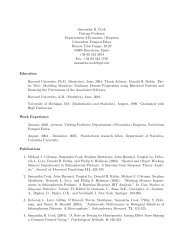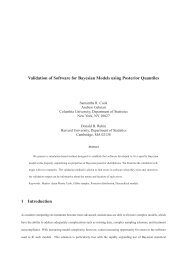Pricing Asian Options in a Semimartingale Model - Department of ...
Pricing Asian Options in a Semimartingale Model - Department of ...
Pricing Asian Options in a Semimartingale Model - Department of ...
You also want an ePaper? Increase the reach of your titles
YUMPU automatically turns print PDFs into web optimized ePapers that Google loves.
<strong>Pric<strong>in</strong>g</strong> <strong>Asian</strong> <strong>Options</strong> <strong>in</strong> a Semimart<strong>in</strong>gale <strong>Model</strong> ∗<br />
Jan Večeř<br />
Columbia University, <strong>Department</strong> <strong>of</strong> Statistics, New York, NY 10027, USA<br />
Kyoto University, Kyoto Institute <strong>of</strong> Economic Research, F<strong>in</strong>ancial Eng<strong>in</strong>eer<strong>in</strong>g Center, Kyoto, Japan<br />
M<strong>in</strong>gx<strong>in</strong> Xu<br />
Carnegie Mellon University, <strong>Department</strong> <strong>of</strong> Mathematical Sciences, Pittsburgh, PA 15213, USA<br />
First version: September 10, 2001<br />
This version: April 26, 2003<br />
Abstract. In this article we study arithmetic <strong>Asian</strong> options when the underly<strong>in</strong>g stock is driven by special<br />
semimart<strong>in</strong>gale processes. We show that the <strong>in</strong>herently path dependent problem <strong>of</strong> pric<strong>in</strong>g <strong>Asian</strong> options<br />
can be transformed <strong>in</strong>to a problem without path dependency <strong>in</strong> the pay<strong>of</strong>f function. We also show that the<br />
price satisfies a simpler <strong>in</strong>tegro-differential equation <strong>in</strong> the case the stock price is driven by a process with<br />
<strong>in</strong>dependent <strong>in</strong>crements, Lévy process be<strong>in</strong>g a special case.<br />
Key words: <strong>Asian</strong> options, Special semimart<strong>in</strong>gales, Lévy processes, Integro-differential equations.<br />
1 Introduction<br />
<strong>Asian</strong> options are securities with pay<strong>of</strong>f which depends on the average <strong>of</strong> the underly<strong>in</strong>g stock price S over a<br />
certa<strong>in</strong> time <strong>in</strong>terval. If we denote by λ the averag<strong>in</strong>g factor <strong>of</strong> the option, we can write the general <strong>Asian</strong><br />
option pay<strong>of</strong>f as<br />
(1.1)<br />
( ( ∫ )) + T<br />
ξ · S t dλ(t) − K 1 S T − K 2 .<br />
0<br />
When K 1 = 0, we have fixed strike option; when K 2 = 0, we have float<strong>in</strong>g strike option. The constant ξ = ±1<br />
determ<strong>in</strong>es whether the option is call or put. The averag<strong>in</strong>g factor λ has f<strong>in</strong>ite variation and is typically taken<br />
to be<br />
λ(t) = t T<br />
for the case <strong>of</strong> cont<strong>in</strong>uously sampled <strong>Asian</strong> options, or<br />
λ(t) = 1 n · ⌊ nt<br />
T<br />
for the case <strong>of</strong> discretely sampled <strong>Asian</strong> options. Other averag<strong>in</strong>g is also possible (exponential, etc.), but less<br />
frequently used <strong>in</strong> practice. Notice that European type options are just a special case <strong>of</strong> <strong>Asian</strong> option for the<br />
follow<strong>in</strong>g choice <strong>of</strong> parameters: λ(t) = 1 {T } (t) and K 1 = 0.<br />
∗ Acknowledgements: We would like to thank Steven Shreve whose careful read<strong>in</strong>g has significantly improved the<br />
manuscript. We have also received valuable suggestions from David Heath, Julien Hugonnier, Dmitry Kramkov, Yoshio Miyahara<br />
and Isaac Son<strong>in</strong>. We would also like to thank the anonymous referee for helpful comments. Takeaki Kariya and F<strong>in</strong>ancial<br />
Eng<strong>in</strong>eer<strong>in</strong>g Center <strong>of</strong> Kyoto University provided us with creative research environment, <strong>in</strong> which we have <strong>in</strong>itiated this project.<br />
The work <strong>of</strong> M<strong>in</strong>gx<strong>in</strong> Xu was supported by the National Science Foundation under grant DMS-0103814.<br />
⌋<br />
1
There has been a grow<strong>in</strong>g concern <strong>in</strong> the literature on the lognormality assumption <strong>of</strong> the underly<strong>in</strong>g<br />
stock price, and a number <strong>of</strong> alternative approaches have been suggested. One <strong>of</strong> the most studied situations<br />
is the case when the stock is driven by a particular Lévy process. Carr, Geman, Madan and Yor (2000)<br />
have recently suggested the so-called CGMY model for the stock price, which shows a good match with<br />
empirical data. Another alternative approach, namely the general hyperbolic model, is discussed <strong>in</strong> Eberle<strong>in</strong><br />
and Prause (1998).<br />
The problem <strong>of</strong> pric<strong>in</strong>g <strong>Asian</strong> options is already complicated when the underly<strong>in</strong>g stock is a geometric<br />
Brownian motion. Most <strong>of</strong> the literature we know studies only this type <strong>of</strong> model. A number <strong>of</strong> approximations<br />
that produce closed form expressions have appeared, most recently <strong>in</strong> Thompson (1999), who provides<br />
tight analytical bounds for the <strong>Asian</strong> option price. Geman and Yor (1993) computed the Laplace transform<br />
<strong>of</strong> the <strong>Asian</strong> option price, and Eydeland and Geman (1995) showed how it can be related to the Fast Fourier<br />
Transform. More recently, Donato-Mart<strong>in</strong>, Ghomrasni and Yor (2001) generalized Laplace transform approach<br />
for the case <strong>of</strong> cont<strong>in</strong>uously sampled <strong>Asian</strong> option where the underly<strong>in</strong>g asset is driven by a Lévy<br />
process. This method uses equivalence <strong>of</strong> law <strong>of</strong> certa<strong>in</strong> exponentials <strong>of</strong> Lévy processes. Exponentials <strong>of</strong> Lévy<br />
processes have been previously studied for <strong>in</strong>stance by Carmona, Petit, Yor (2001).<br />
Rogers and Shi (1995) have formulated a one-dimensional PDE that can model both float<strong>in</strong>g and fixed<br />
strike cont<strong>in</strong>uous average <strong>Asian</strong> options. They apply the technique <strong>of</strong> change <strong>of</strong> numeraire <strong>in</strong>troduced <strong>in</strong><br />
Geman, El Karoui and Rochet (1995) to reduce the dimensionality <strong>of</strong> the pric<strong>in</strong>g problem. Andreasen (1998)<br />
has extended this approach for pric<strong>in</strong>g discretely sampled <strong>Asian</strong> option. L<strong>in</strong>etsky (2002) computed the price<br />
<strong>of</strong> cont<strong>in</strong>uously sampled <strong>Asian</strong> option us<strong>in</strong>g analytical expansion method, however this technique is limited<br />
to diffusions.<br />
Monte Carlo methods seem to work well, but sampl<strong>in</strong>g the entire path <strong>of</strong> the underly<strong>in</strong>g asset greatly<br />
reduces competitiveness <strong>of</strong> this approach, even with the help <strong>of</strong> variation reduction techniques (Fu, Madan,<br />
Wang (1998/99)).<br />
In the recent paper <strong>of</strong> Večeř (2002), it was shown that one can reformulate the problem <strong>of</strong> pric<strong>in</strong>g<br />
<strong>Asian</strong> options <strong>in</strong> a way which removes the <strong>in</strong>herent path dependency <strong>of</strong> the contract. This paper applies<br />
the techniques developed <strong>in</strong> Shreve and Večeř (2000) for pric<strong>in</strong>g options on a traded account. The model<br />
discussed there assumes that the underly<strong>in</strong>g stock is a geometric Brownian motion, <strong>in</strong> which case one can<br />
obta<strong>in</strong> a simple one-dimensional partial differential equation for the price which is easy to solve numerically.<br />
A similar formulation <strong>of</strong> the pric<strong>in</strong>g partial differential equation appears <strong>in</strong> an <strong>in</strong>dependent work <strong>of</strong> Hoogland<br />
and Neumann (2001).<br />
We show <strong>in</strong> this article that the approach <strong>of</strong> remov<strong>in</strong>g the path dependency <strong>in</strong> the formulation <strong>of</strong> the<br />
<strong>Asian</strong> option pric<strong>in</strong>g problem can be generalized to the case when the underly<strong>in</strong>g asset is driven by a special<br />
semimart<strong>in</strong>gale process. We also show that the price satisfies an <strong>in</strong>tegro-differential equation <strong>in</strong> the case<br />
the stock price is driven by a process with <strong>in</strong>dependent <strong>in</strong>crements, Lévy processes be<strong>in</strong>g a special case.<br />
Integro-differential equations have been previously applied <strong>in</strong> a different context for modell<strong>in</strong>g <strong>of</strong> perpetuities<br />
or <strong>in</strong> the risk theory; see for <strong>in</strong>stance Paulsen (1998).<br />
2 <strong>Pric<strong>in</strong>g</strong> Formula for <strong>Asian</strong> <strong>Options</strong><br />
Let S be a real-valued, strictly positive semimart<strong>in</strong>gale on the stochastic basis (Ω, F, F = (F t ) t∈R+ , P) that<br />
satisfies the usual conditions. We will from now on assume P to be a risk-neutral measure and the <strong>in</strong>terest<br />
rate to be a constant r. In particular, we assume that e −rt S t is a mart<strong>in</strong>gale under P † .<br />
In order to reformulate the pric<strong>in</strong>g problem and to remove the path dependency <strong>in</strong> <strong>Asian</strong> option valuation,<br />
we will def<strong>in</strong>e the <strong>Asian</strong> forward contract and use the follow<strong>in</strong>g procedure <strong>of</strong> replicat<strong>in</strong>g the <strong>Asian</strong> forward<br />
pay<strong>of</strong>f. Without loss <strong>of</strong> generality, we assume ξ = 1.<br />
† Here we will not discuss <strong>in</strong> detail how to choose this equivalent mart<strong>in</strong>gale measure for pric<strong>in</strong>g purpose. Interested readers<br />
are referred to Föllmer and Schweizer (1991) for the Föllmer-Schweizer m<strong>in</strong>imal measure; Miyahara (2001) and Frittelli (2000)<br />
for the m<strong>in</strong>imal entropy mart<strong>in</strong>gale measure; Bell<strong>in</strong>i and Frittelli (1998) for the m<strong>in</strong>imax measure; Goll and Rüschendorf (2001)<br />
for the m<strong>in</strong>imal distance mart<strong>in</strong>gale measures; Elliott, Hunter, Kopp and Madan (1995) for the equivalent mart<strong>in</strong>gale measure<br />
result<strong>in</strong>g from multiplicative decomposition; Gerber and Shiu (1994) for Esscher transform. A nice presentation <strong>of</strong> earlier results<br />
for geometric Lévy processes can be found <strong>in</strong> Chan (1999).<br />
2
Def<strong>in</strong>ition 2.1 (<strong>Asian</strong> forward contract) An <strong>Asian</strong> forward contract has the follow<strong>in</strong>g pay<strong>of</strong>f at maturity<br />
date T :<br />
(2.1)<br />
∫ T<br />
0<br />
S t dλ(t) − K,<br />
where S t is the underly<strong>in</strong>g process, λ(t) is the averag<strong>in</strong>g factor, and K is a constant.<br />
The difference between <strong>Asian</strong> forward and <strong>Asian</strong> option is that the pay<strong>of</strong>f <strong>of</strong> <strong>Asian</strong> option (with fixed<br />
strike) is the positive part <strong>of</strong> the <strong>Asian</strong> forward pay<strong>of</strong>f. An important feature <strong>of</strong> forward contracts is that<br />
their price does not depend on the choice <strong>of</strong> the risk neutral measure. Thus the price <strong>of</strong> forwards is model<br />
<strong>in</strong>dependent and there is a uniquely def<strong>in</strong>ed hedge q t . This fact is shown <strong>in</strong> the follow<strong>in</strong>g proposition. By<br />
simple observation that options and forwards differ only <strong>in</strong> the pay<strong>of</strong>f while hav<strong>in</strong>g the same pric<strong>in</strong>g equation,<br />
we will be able to characterize the <strong>Asian</strong> option price <strong>in</strong> the next section.<br />
Proposition 2.2 (Replication <strong>of</strong> the <strong>Asian</strong> forward contract) Suppose that we have a self-f<strong>in</strong>anc<strong>in</strong>g<br />
portfolio X evolv<strong>in</strong>g as<br />
(2.2) dX t = q t− dS t + r(X t− − q t− S t− )dt,<br />
where S t is a semimart<strong>in</strong>gale. If we set the shares <strong>in</strong>vested <strong>in</strong> the stock to be<br />
∫ T<br />
(2.3) q t = e −rT e rs dλ(s)<br />
where λ(t) is a determ<strong>in</strong>istic function with f<strong>in</strong>ite variation, and start with the <strong>in</strong>itial wealth<br />
(2.4) X 0 = q 0 S 0 − e −rT K 2 ,<br />
then we will have<br />
(2.5) X T =<br />
∫ T<br />
0<br />
t<br />
S t dλ(t) − K 2 .<br />
Pro<strong>of</strong>. For notational purpose, let B t = e −rt S t . By the def<strong>in</strong>ition <strong>of</strong> quadratic variation and (2.2),<br />
(2.6) e −rT X T − X 0 =<br />
S<strong>in</strong>ce q t is <strong>of</strong> f<strong>in</strong>ite variation,<br />
∫ T<br />
0<br />
B t− dq t + [q, B] t =<br />
∫ T<br />
0<br />
∫ T<br />
0<br />
q t− dB t = q T B T − q 0 S 0 −<br />
B t− dq t + ∑<br />
0
Theorem 2.3 (<strong>Pric<strong>in</strong>g</strong> Formula) Let V λ (0, S 0 , K 1 , K 2 ), the price <strong>of</strong> the <strong>Asian</strong> option with the pay<strong>of</strong>f (1.1)<br />
when ξ = 1, be def<strong>in</strong>ed as<br />
⎡ ( ∫ ) ⎤ + T<br />
(2.8) V λ (0, S 0 , K 1 , K 2 ) E P ⎣e −rT S t dλ(t) − K 1 S T − K 2<br />
⎦ .<br />
Then we have the follow<strong>in</strong>g relationship<br />
(2.9) V λ (0, S 0 , K 1 , K 2 ) = S 0 · E Q [(Z T − K 1 ) + ]<br />
where Q is def<strong>in</strong>ed by (2.7), X t is the self-f<strong>in</strong>anc<strong>in</strong>g portfolio (2.2) with the <strong>in</strong>itial condition X 0 and trad<strong>in</strong>g<br />
strategy q t def<strong>in</strong>ed <strong>in</strong> (2.4) and (2.3), and Z t = Xt<br />
S t<br />
.<br />
0<br />
Pro<strong>of</strong>. An easy consequence <strong>of</strong> proposition 2.2 is<br />
⎡( ∫ T<br />
V λ (0, S 0 , K 1 , K 2 ) = e −rT · E P ⎣<br />
0<br />
) ⎤ +<br />
S t dλ(t) − K 1 S T − K 2<br />
⎦<br />
= e −rT · E P [ (X T − K 1 S T ) +]<br />
= e −rT · E Q [<br />
(X T − K 1 S T ) + S 0 e rT<br />
S T<br />
]<br />
= S 0 · E Q [(Z T − K 1 ) + ].<br />
⋄<br />
3 Integro-Differential Equation<br />
For our next analysis, we need the follow<strong>in</strong>g result:<br />
Lemma 3.1 Z t = Xt<br />
S t<br />
is a local mart<strong>in</strong>gale under Q.<br />
Pro<strong>of</strong>. Recall that P is a risk-neutral measure. Equation (2.2) and the fact that q t is determ<strong>in</strong>istic ensure<br />
that e −rt X t is a mart<strong>in</strong>gale. For 0 ≤ u ≤ t,<br />
E Q [Z t |F u ] = S 0e ru [ ]<br />
E P St Z t<br />
S 0 e rt | F u<br />
S u<br />
= eru<br />
S u<br />
E P [ e −rt X t | F u<br />
]<br />
= eru<br />
e −ru X u = Z u .<br />
S u<br />
⋄<br />
To derive the <strong>in</strong>tegro-differential equation, we need to impose more restrictions on the structure <strong>of</strong> the<br />
stock price to get the Markovian property. Let H be a semimart<strong>in</strong>gale on the same stochastic basis (Ω, F, F =<br />
(F t ) t∈R+ , P), with values <strong>in</strong> R and H 0 = 0. Suppose the stock price has the follow<strong>in</strong>g dynamics:<br />
(3.1) dS t = S t− dH t ,<br />
S<strong>in</strong>ce we have assumed e −rt S t to be a mart<strong>in</strong>gale under P, H is necessarily a special semimart<strong>in</strong>gale. Follow<strong>in</strong>g<br />
the notation <strong>in</strong> Jacod and Shiryaev (2002), H has the canonical decomposition:<br />
(3.2) H t = rt + H c t +<br />
∫ t ∫ ∞<br />
0<br />
−∞<br />
x (µ(ds, dx) − ν(ds, dx)) ,<br />
4
where Ht<br />
c is the cont<strong>in</strong>uous mart<strong>in</strong>gale part, µ(dt, dx) is the random measure associated with the jumps <strong>of</strong><br />
H and ν(dt, dx) is the compensator. Accord<strong>in</strong>g to II.2.9 and II.2.29 <strong>in</strong> Jacod and Shiryaev (2002), we can<br />
always choose a good version <strong>of</strong> ν, i.e., ν({t}, R) ≤ 1, ν(R + , {0}) = 0 and ∫ t ∫ ∞<br />
0 −∞ (|x|2 ∧ |x|)ν(dt, dx) is a<br />
process with locally <strong>in</strong>tegrable variation. The assumption <strong>of</strong> the strict positiveness <strong>of</strong> S translates to the<br />
follow<strong>in</strong>g assumption<br />
Assumption 3.2 µ([0, t], (−∞, −1]) = 0 for all t ≥ 0.<br />
The Doléans-Dade formula gives<br />
(3.3) S t = S 0 E(H) = S 0 exp ( H t − 1 2 〈Hc 〉 t<br />
) ∏<br />
0
We can write<br />
( )<br />
d<br />
Xt<br />
S t<br />
=<br />
=<br />
=<br />
( ) ( ) ( ) ( )<br />
X t<br />
S t<br />
− Xt−<br />
S t−<br />
= q t− − Xt−<br />
S t−<br />
1 − 1<br />
1+∆H t<br />
= q t− − Xt− ∆Ht<br />
S t− 1+∆H t<br />
.<br />
( ) (<br />
)<br />
q t− − Xt−<br />
S t−<br />
dH t − rdt − d〈H c 〉 t +<br />
( ) (<br />
q t− − Xt−<br />
S t−<br />
dH t − rdt − d〈H c 〉 t −<br />
( ) ( ∫ ∞<br />
q t− − Xt−<br />
S t−<br />
dHt c − d〈H c 〉 t +<br />
−∞<br />
(<br />
q t− − Xt−<br />
S t−<br />
) (<br />
∆Ht<br />
1+∆H t<br />
− ∆H t<br />
)<br />
.<br />
)<br />
∆H2 t<br />
1+∆H t<br />
x (µ(dt, dx) − ν(dt, dx)) −<br />
∫ ∞<br />
−∞<br />
)<br />
x 2<br />
1+x µ(dt, dx)<br />
or<br />
(<br />
∫ ∞<br />
∫ ∞<br />
)<br />
dZ t = (q t− − Z t− ) dHt c − d〈H c x<br />
〉 t + x (µ(dt, dx) − ν(dt, dx)) −<br />
2<br />
1+x µ(dt, dx) .<br />
−∞<br />
−∞<br />
Observe that Z t is a Markovian process under Q. Theorem 2.3 and the Markovian property give us the value<br />
process<br />
v(t, Z t ) = E Q [(Z T − K 1 ) + |F t ],<br />
which is a mart<strong>in</strong>gale by def<strong>in</strong>ition.<br />
Note d〈Z c 〉 t = (q t− − Z t− ) 2 d〈H c 〉 t and thus<br />
dv(t, Z t ) = v t (t, Z t− )dt + v z (t, Z t− )dZ + 1 2 v zz(t, Z t− )d〈Z c 〉 t<br />
+v(t, Z t ) − v(t, Z t− ) − v z (t, Z t− )∆Z t<br />
= v t (t, Z t− )dt + v z (t, Z t− )dZ + 1 2 v zz(t, Z t− )(q t− − Z t− ) 2 d〈H c 〉 t<br />
(<br />
)<br />
+v t, Z t− + (q t− − Z t− ) ∆H<br />
1+∆H<br />
− v(t, Z t− ) − v z (t, Z t− )(q t− − Z t− ) ∆H<br />
1+∆H<br />
= Local Mart<strong>in</strong>gale + v t (t, Z t− )dt + 1 2 v zz(t, Z t− )(q t− − Z t− ) 2 d〈H c 〉 t<br />
∫ ∞ { (<br />
)<br />
+ v t, Z t− + (q t− − Z t− ) x<br />
1+x<br />
−∞<br />
}<br />
−v(t, Z t− ) − v z (t, Z t− )(q t− − Z t− ) x<br />
1+x<br />
ν(dt, dx).<br />
The fact that a predictable local mart<strong>in</strong>gale with f<strong>in</strong>ite variation start<strong>in</strong>g at zero is zero concludes the pro<strong>of</strong>.<br />
⋄<br />
Corollary 3.4 In the case when H is a Lévy process, the <strong>in</strong>tegro-differential equation simplifies to<br />
(3.5) v t (t, z) + c 2 v zz(t, z)(q t− − z) 2<br />
for 0 ≤ t ≤ T and z ∈ R.<br />
+<br />
∫ ∞<br />
−∞<br />
{ (<br />
)<br />
}<br />
v t, z + (q t− − z) x<br />
1+x<br />
− v(t, z) − v z (t, z)(q t− − z) x<br />
1+x<br />
K(dx) = 0<br />
Pro<strong>of</strong>. The canonical decomposition <strong>of</strong> H is<br />
H t = rt +<br />
∫ t<br />
0<br />
√ c dWs +<br />
∫ t<br />
0<br />
∫ ∞<br />
−∞<br />
x ( µ(ds, dx) − K(dx)dt )<br />
where W t is a standard Brownian Motion. Apply<strong>in</strong>g theorem 3.3, we get<br />
(3.6) v t (t, Z t− ) + c 2 v zz(t, Z t− )(q t− − Z t− ) 2<br />
∫ ∞ {<br />
+ v<br />
−∞<br />
(<br />
t, Z t− + (q t− − Z t− ) x<br />
1+x<br />
S<strong>in</strong>ce the support for Z t− is R, we get the above equation.<br />
)<br />
}<br />
− v(t, Z t− ) − v z (t, Z t− )(q t− − Z t− ) x<br />
1+x<br />
K(dx) = 0.<br />
⋄<br />
6
4 Applications to Different Lévy <strong>Model</strong>s<br />
1. Geometric Brownian Motion with Poisson Jump<br />
Let us start with a model similar to the one suggested <strong>in</strong> Andreasen (1998). Suppose that the stock price<br />
process evolves as<br />
dS t = S t− dH t = S t−<br />
(<br />
rdt + σdWt + (e φt − 1)dM t<br />
)<br />
,<br />
where W t is a standard Brownian motion, and M t is a compensated Poisson process, i.e., M t = N t − λt. Let<br />
φ t be a Gaussian process with <strong>in</strong>dependent <strong>in</strong>crements, and be <strong>in</strong>dependent <strong>of</strong> both W t and N t , such that<br />
E[φ t ] = µ and Var[φ t ] = γ 2 . Assume that γ > 0, σ > 0, µ are constants. In this case,<br />
}<br />
〈H〉 t = σ 2 t, K(x) = √ λ<br />
2πγ · exp<br />
{− (ln(x+1)−µ)2<br />
γ<br />
,<br />
2<br />
and v(t, z) satisfies (3.4). If γ = 0, then the jump size reduces to a constant e µ − 1, i.e., K(x) = λ δ({e µ − 1})<br />
and (3.4) simplifies to:<br />
(4.1) v t (t, z) + σ2<br />
2 v zz(t, z)(q t− − z) 2 [ (<br />
)<br />
]<br />
+ v t, z + (q t− − z) φ<br />
1+φ<br />
− v(t, z) − (q t− − z)v z (t, z) φ<br />
1+φ λ = 0,<br />
for 0 ≤ t ≤ T . In the geometric Brownian model, dS t = S t− dH t = S t− (rdt + σdW t ), φ = 0, and we simply<br />
have<br />
(4.2) v t (t, z) + σ2<br />
2 (q t − z) 2 v zz (t, z) = 0,<br />
as shown <strong>in</strong> Večeř (2001).<br />
2. Pure Jump Processes <strong>Model</strong>s: CGMY and General Hyperbolic<br />
In our model (3.1),<br />
(4.3) dS t = S t− dH t ,<br />
the stock price is a stochastic exponential <strong>of</strong> H. Another usual approach <strong>in</strong> the literature is to let the stock<br />
price to be a geometric exponential <strong>of</strong> the underly<strong>in</strong>g:<br />
(4.4) S t = S 0 eĤt .<br />
Apply<strong>in</strong>g Ito’s lemma and rewrit<strong>in</strong>g (3.3):<br />
dS t =<br />
(dĤt + 1 )<br />
(4.5)<br />
eĤt− 2 d〈Ĥc 〉 t + e ∆Ĥt − 1 − ∆Ĥt ,<br />
⎧<br />
⎫<br />
⎨<br />
S t = S 0 exp<br />
⎩ H t − 1 2 〈Hc 〉 t + ∑<br />
⎬<br />
(4.6)<br />
(ln(1 + ∆H s ) − ∆H s )<br />
⎭ .<br />
We can easily f<strong>in</strong>d the relationship between H and Ĥ:<br />
(4.7)<br />
(4.8)<br />
H t = Ĥt + 1 2 〈Ĥc 〉 t + ∑<br />
0
Therefore the two ways <strong>of</strong> modell<strong>in</strong>g are equivalent with Assumption 3.2. If we are given the compensator<br />
̂µ(dt, dx) for the model (4.4), then the IDE <strong>in</strong> corollary (3.4) becomes<br />
(4.9) ̂v t (t, z) + c 2 ̂v zz(t, z)(q t− − z) 2 +<br />
∫ ∞ { (<br />
)<br />
}<br />
̂v t, z + (q t− − z) êx −1<br />
− ̂v(t, z) − ̂v êx z (t, z)(q t− − z) êx −1 ̂K(d̂x) = 0,<br />
êx<br />
−∞<br />
because ∆H t = e ∆Ĥt − 1.<br />
We mention here two geometric exponential models with pure jump processes. One is CGMY <strong>in</strong> Carr,<br />
Geman, Madan, Yor (2000) with Lévy measure:<br />
{<br />
C<br />
exp(−G|̂x|)<br />
, for ̂x < 0;<br />
|̂x| ̂kCGMY =<br />
1+Y C exp(−M|̂x|) , for ̂x > 0.<br />
|̂x| 1+Y<br />
The other is the General Hyperbolic <strong>Model</strong> <strong>in</strong> Eberle<strong>in</strong> and Prause (1998) with Lévy measure:<br />
⎧ ( ( √ )<br />
)<br />
e ∫<br />
⎪⎨<br />
β ̂x ∞ exp − 2y+α 2 |̂x|<br />
|̂x| 0 π 2 y(Jλ 2 ̂kEP =<br />
(δ√ 2y)+Yλ 2(δ√ 2y)) dy + λe−α|̂x| , if λ ≥ 0;<br />
( ( √ ) )<br />
⎪⎩<br />
e ∫ β ̂x ∞ exp − 2y+α 2 |̂x|<br />
|̂x| 0 π 2 y(J−λ 2 (δ√ 2y)+Y−λ 2 (δ√ 2y)) dy , if λ < 0;<br />
where J λ and Y λ are the Bessel functions <strong>of</strong> the first and second k<strong>in</strong>d respectively. In both models the value<br />
<strong>of</strong> the <strong>Asian</strong> option satisfy:<br />
(4.10) ̂v t (t, z) +<br />
for 0 ≤ t ≤ T .<br />
3. Numerical Issues<br />
∫ ∞<br />
−∞<br />
{ (<br />
)<br />
}<br />
̂v t, z + (q t− − z) êx −1<br />
− ̂v(t, z) − ̂v êx z (t, z)(q t− − z) êx −1 ̂K(d̂x) = 0,<br />
êx<br />
Integro-differential equations can be solved numerically. The numerical procedures for solv<strong>in</strong>g <strong>in</strong>tegrodifferential<br />
equations <strong>in</strong> option pric<strong>in</strong>g have been recently studied for <strong>in</strong>stance <strong>in</strong> Hirsa and Madan (2001).<br />
They have developed discretization scheme which applies to the case <strong>of</strong> <strong>Asian</strong> option as well.<br />
There are several alternative methods for pric<strong>in</strong>g <strong>Asian</strong> options <strong>in</strong> the geometric Brownian motion model,<br />
especially for cont<strong>in</strong>uously averaged <strong>Asian</strong>. In this case our pric<strong>in</strong>g equation becomes a two-term partial<br />
differential equation which is simple to implement. Extensive comparisons <strong>of</strong> different methods are documented<br />
<strong>in</strong> Večeř (2002), with the conclusion that several alternative approaches obta<strong>in</strong> prices with arbitrary<br />
precision. These methods <strong>in</strong>clude Večeř’s partial differential equation, Geman-Yor (1993) Laplace transform<br />
and L<strong>in</strong>etsky’s (2002) analytical expansion method. The pric<strong>in</strong>g partial differential equation presented here<br />
is numerically stable and the convergence <strong>of</strong> the numerical scheme is not affected by the choice <strong>of</strong> underly<strong>in</strong>g<br />
parameters.<br />
5 Conclusion<br />
We have shown <strong>in</strong> this paper that we can remove the path dependency <strong>in</strong> the pay<strong>of</strong>f function <strong>of</strong> all k<strong>in</strong>ds <strong>of</strong><br />
<strong>Asian</strong> options regardless <strong>of</strong> the dynamics <strong>of</strong> the underly<strong>in</strong>g asset. This reformulation <strong>of</strong> the problem gives us<br />
an <strong>in</strong>tegro-differential equation for the price <strong>of</strong> the option when the stock is driven by an exponential Lévy<br />
process. This equation simplifies even more if we assume a particular stock price model, such as Geometric<br />
Brownian Motion with Poisson Jump model, the Carr, Geman, Madan, Yor model, or a general hyperbolic<br />
model. In the case <strong>of</strong> Black-Scholes model, we obta<strong>in</strong> a one-dimensional PDE which is simple and robust to<br />
implement.<br />
8
References<br />
[1] Andreasen, J. (1998): “The pric<strong>in</strong>g <strong>of</strong> discretely sampled <strong>Asian</strong> and lookback options: a change <strong>of</strong><br />
numeraire approach”, The Journal <strong>of</strong> Computational F<strong>in</strong>ance Vol. 2, No. 1, 5–30.<br />
[2] Bel<strong>in</strong>i, F., M. Fritelli (1998): “On the existence <strong>of</strong> m<strong>in</strong>imax mart<strong>in</strong>gale measures”, Work<strong>in</strong>g paper,<br />
University <strong>of</strong> Milano.<br />
[3] Carmona, P., Petit, F., Yor, M. (2001) “Exponential functionals <strong>of</strong> Lévy processes,” Lévy<br />
Processes Theory and Applications (S. Resnick, O. Barndorff-Nielsen, T. Mikosch, ed.), pp. 41–55,<br />
Birkhauser.<br />
[4] Carr, P., H. Geman, D. Madan, M. Yor (2002): “The f<strong>in</strong>e structure <strong>of</strong> asset returns: An empirical<br />
<strong>in</strong>vestigation”, Journal <strong>of</strong> Bus<strong>in</strong>ess, Vol. 75, 305–332.<br />
[5] Chan, T. (1999): “<strong>Pric<strong>in</strong>g</strong> cont<strong>in</strong>gent claims on stocks driven by Lévy processes”, The Annals <strong>of</strong><br />
Applied Probability, Vol. 9, No. 2, 504-528.<br />
[6] Curran, M. (1992): “Beyond average <strong>in</strong>telligence”, Risk 5/1992, page 60.<br />
[7] Donato-Mart<strong>in</strong>, C., R. Ghomrasni, M. Yor (2001): “On Certa<strong>in</strong> Markov Processes Attached<br />
to Exponential Functionals <strong>of</strong> Brownian Motion; Application to <strong>Asian</strong> <strong>Options</strong>”, Revista Math Ibero –<br />
Americana, Vol. 17, No. 1, 179–193.<br />
[8] Eberle<strong>in</strong>, E., K. Prause (1998): “The generalized hyperbolic model: F<strong>in</strong>ancial derivatives and risk<br />
measures.”, FDM-Prepr<strong>in</strong>t, 56.<br />
[9] Elliott, R. J., W. C. Hunter, P. E. Kopp, D. Madan (1995): “<strong>Pric<strong>in</strong>g</strong> via multiplicative price<br />
decomposition”, Journal <strong>of</strong> F<strong>in</strong>ancial Eng<strong>in</strong>eer<strong>in</strong>g, 4, 247-262.<br />
[10] Föllmer, H., M. Schweizer (1991): “Hedg<strong>in</strong>g <strong>of</strong> cont<strong>in</strong>gent claims under <strong>in</strong>complete <strong>in</strong>formation”,<br />
Applied Stochastic Analysis (M. H. A. Davis and R. J. Elliott, eds.), Gordon and Breach, New York,<br />
389-414.<br />
[11] Frittelli M. (2000): “The M<strong>in</strong>imal Entropy Mart<strong>in</strong>gale Measure and the Valuation Problem <strong>in</strong><br />
Incomplete Markets”, Mathematical F<strong>in</strong>ance, Vol. 10, No. 1, 39-52.<br />
[12] Fu, M., D. Madan, T. Wang (1998/99): “<strong>Pric<strong>in</strong>g</strong> cont<strong>in</strong>uous <strong>Asian</strong> options: a comparison <strong>of</strong> Monte<br />
Carlo and Laplace transform <strong>in</strong>version methods”, The Journal <strong>of</strong> Computational F<strong>in</strong>ance, Vol. 2, No. 2.<br />
[13] Geman, H., N. El Karoui, J. C. Rochet (1995): Changes <strong>of</strong> numeraire, changes <strong>of</strong> probability<br />
measures and pric<strong>in</strong>g <strong>of</strong> options, Journal <strong>of</strong> Applied Probability, 32, 443–458.<br />
[14] Geman, H., A. Eydeland (1995): “Dom<strong>in</strong>o effect”, Risk 8, 65–67.<br />
[15] Geman, H., M. Yor (1993): “Bessel processes, <strong>Asian</strong> option, and perpetuities”, Mathematical F<strong>in</strong>ance,<br />
3, 349–375.<br />
[16] Gerber, H. U., E. S. W. Shiu (1994): “Option pric<strong>in</strong>g by Esscher transforms (with discussion)”,<br />
Trans. Soc. Actuaries, 46, 99-191.<br />
[17] Goll, T., L. Rüschendorf (2001): “M<strong>in</strong>imax and m<strong>in</strong>imal distance mart<strong>in</strong>gale measures and their<br />
relationship to portfolio optimization”, F<strong>in</strong>ance and Stochastics Vol. 5, No. 4, 557-581.<br />
[18] Hirsa, A., Madan, D. (2001): “<strong>Pric<strong>in</strong>g</strong> American <strong>Options</strong> under Variance Gamma”, Work<strong>in</strong>g Paper.<br />
[19] Hoogland, J., D. Neumann (2001): “Local Scale Invariance and Cont<strong>in</strong>gent Claim <strong>Pric<strong>in</strong>g</strong>”, International<br />
Journal <strong>of</strong> Theoretical and Applied F<strong>in</strong>ance, 4/1, 1–21.<br />
9
[20] Hoogland, J., D. Neumann (2000): “<strong>Asian</strong>s and cash dividends: Exploit<strong>in</strong>g symmetries <strong>in</strong> pric<strong>in</strong>g<br />
theory”, Work<strong>in</strong>g paper.<br />
[21] Jacod, J., A. N. Shiryaev (2002): Limit Theorems for Stochastic Processes, Second Edition,<br />
Spr<strong>in</strong>ger-Verlag.<br />
[22] L<strong>in</strong>etsky, V., (2002): “Exact <strong>Pric<strong>in</strong>g</strong> <strong>of</strong> <strong>Asian</strong> <strong>Options</strong>: An Application <strong>of</strong> Spectral Theory”, Work<strong>in</strong>g<br />
Paper.<br />
[23] Miyahara, Y. (2001): “ [Geometric Lévy Process & MEMM] <strong>Pric<strong>in</strong>g</strong> <strong>Model</strong> and Related Estimation<br />
Problems”, Asia-Pacific F<strong>in</strong>ancial Markets, Vol. 8, No. 1, 45–60.<br />
[24] Paulsen, J. (1998): “Sharp conditions for certa<strong>in</strong> ru<strong>in</strong> <strong>in</strong> a risk process with stochastic return on<br />
<strong>in</strong>vestments”, Stochastic Processes and their Applications, Vol. 75, 135–148.<br />
[25] Rogers, C., Z. Shi (1995): “The value <strong>of</strong> an <strong>Asian</strong> option”, Journal <strong>of</strong> Applied Probability, 32,<br />
1077–1088.<br />
[26] Shreve, S., J. Večeř (2000): “<strong>Options</strong> on a traded account: Vacation calls, vacation puts and<br />
passport options”, F<strong>in</strong>ance and Stochastics, 255–274.<br />
[27] Thompson, G., (1999): “Fast narrow bounds on the value <strong>of</strong> <strong>Asian</strong> options”, Work<strong>in</strong>g paper.<br />
[28] Večeř, J. (2001): “A new PDE approach for pric<strong>in</strong>g arithmetic average <strong>Asian</strong> options”, The Journal<br />
<strong>of</strong> Computational F<strong>in</strong>ance, Vol. 4, No. 4, 105-113.<br />
[29] Večeř, J. (2002): “Unified <strong>Asian</strong> <strong>Pric<strong>in</strong>g</strong>”, Risk, Vol. 15, No. 6, 113–116.<br />
10


